You’ve already mastered segmentation in your everyday life. Your relationship with your family, friends, and colleagues is the biggest proof of your mastery.
Why?
Because you know what everyone around you likes and dislikes.
And you tailor to their segment their behaviors, needs, lifestyles, and hobbies to keep them happy.
If your best friend is a fitness freak, you buy her an annual fitness membership on her birthday.
You never ask your colleague to go out on Thursday night because he has an Italian class after work.
You bring your son gummy bears because he loves candy.
For your daughter, you buy a set of crayons because she loves drawing.
You’ll be less likely to buy a yellow dress for your wife if you know she hates that color. So what do you do?
- You know how to make people around you happy.
- You know how to avoid bad decisions.
- You spend your resources where you know it’s worth it.
If you can deliver your message at the right time, you can get better in your relationships. It’s the same with your customers.
If you know what they want, you can get better results and higher ROIs.
In this eBook, you’ll learn how to better approach your customer segmentation using Salesforce Marketing Cloud, with the latest segmentation strategies and tips. You’ll start with the basics, and gradually you’ll learn some best practices.
Together we’ll go over:
- Five reasons why personalization makes your marketing better
- Why do you need segmentation?
- Five data segmentation strategies you should know.
- Real scenarios and examples from the retail, education, and insurance industry.
- The business process of segmentation
- A faster and better way to increase your ROIs and save time.
So, let’s start at the base and understand why people like personal messages.
Five Reasons Why Segmentation Makes Your Marketing Better
You are at home watching TV with your family.
*Knock, knock.*
Who’s there?
…….
No answer comes from the other side. You would probably ignore it, and you might even call the police. This is what we like to compare to an unsubscribe.
But what if it’s someone you know who’s knocking at the door? And they say:
“Hey, Mary, it’s me. I brought you your favorite drink. I thought you could enjoy it while we watch your favorite show together.”
Well, that’s something else. If the knocker is someone you know and conveys a personalized message, then you would open the door. This is what happens in marketing nowadays.
Brands overload their customers’ inboxes with non-personalized messages. And of course, they get ignored. How do we know that personalization works? Well, there is proof backed by science.
What is the sweetest sound to your ears? It’s your name. When you hear or read your name, something interesting happens in your brain. Your name triggers a unique reaction that is associated with long-term memory.
Remember this?

The same thing happens when you send personalized content. Your customers tend to remember your brand.
Let’s go over five benefits of personalization
Improved customer experience
Information bombardment doesn’t work anymore. 58% of consumers think personalization plays a crucial role in determining purchase intention. Plus, they think it’s important for brand reputation. Also, 57% of them are ready to share more data if you approach them with tailored campaigns.
Increase in revenue
Your job is not done once your customers buy from you. The goal should be to increase customers’ lifetime value. How can you do that?
By crafting campaigns based on the previous purchase decision of your customers. Here are some examples:
- Identify which channels your customers prefer and follow up on those channels.
- Set up loyalty programs and make them feel special.
- Offer similar products with a personalized message.
- Send special discount codes on special days like their anniversary, birthday etc.
Increases customer retention
You can segment your warm or cold customers in SFMC. A good way to use that data is to segment your customers based on their last visit.
After the segmentation, you can send them tailored campaigns to re-activate them. Or you can send them their abandoned cart items.
You can reward your frequent customers. There are tons of ways, but free delivery or free samples are popular options here.
Increases brand loyalty
When you love a brand, you become a loyal customer. Why do people love Starbucks? Their application is the source of retention and brand loyalty. They make their customers happy by sending personal offers, discounts and Starbucks points.
As you see, today, marketing is all about personalization. Consumers choose brands that make life easier for them. Brands that understand them and respect their time. But how can you communicate with thousands of people at the same time and make them feel special? It all starts with segmentation, and that’s where we are heading!
Prevent attrition
All of your customers are the result of your hard work. You develop all those strategies, ideas and campaigns, then finally, you turn people into your customers.
But your work here is not done yet. It has just started. Now the challenge is to create retention campaigns to keep them in the loop. And the biggest challenge is to keep them with you; to prevent unsubscribes, spam, reports and all kinds of attrition.
Here, the right message at the right time plays a huge role in your growth. If you don’t segment your audiences and send random messages to your customers, you’ll lose them. And once you lose them, it’s hard to get them back! Ultimately you’ll churn and decrease your company’s annual growth rate.
What Is Audience Segmentation, And Why Is It Important?
Your audience is a pool of diverse people. They’re scattered all over the world and have different lifestyles, needs, interests, and problems. When you send a single message to all of them, it won’t click with a considerable part. As a result, you’ll have poor outcomes. The smarter way to send your messages is to segment your audience., splitting your main list(s) into multiple smaller segments that fit specific criteria.

Let’s see why audience segmentation is so important with an example:
You’re a clothing brand. And you have a bi-weekly newsletter about urban style and your new collections. A part of your customers signed up for that newsletter. They’re pretty happy to receive your emails and the opening rates of your newsletter are quite high. But you’re sending the newsletter to all. There is also a group of people who signed up for a 20% discount code.
So what are the possible outcomes here?
Your open rates could drop down by 20%. Or even worse, you might see 9% of your audience flagged the mail you’ve sent as spam. As a result, you’ll lose your hard-earned leads. It’ll undermine your conversions and email reputation.
However, here you can turn the tides. All you have to do is to split your audience into two. Then send your newsletter to your loyal readers. And send only discounts and promotional emails to the other audience.
That’s it. Yes, this is a simple example. But it can be that easy to get better results!
As you learn the different segmentation categories, you can think of broader possibilities. And this is what you’re going to learn now.
4 Types Of Market Segmentation
How personal can you get? How can you craft the most personalized journey for your customers?
Here is an infamous example from the retailer Target:
A father was angry at Target because they were sending his daughter coupons related to baby products. But in fact, his daughter was pregnant, and Target was able to predict it (before her father).
Scary? We think it’s incredible. We’ll dissect this story for you in the next chapter. You’ll learn precisely how.
But first, learn these four elements of segmentation. Digest it well, and soon you’ll start to see your data from a bird’s-eye view. This will help you to brainstorm new territories and possibilities. Eventually, you’ll craft better journeys. Maybe even predict pregnancy.

Demographic Segmentation
Demographic segmentation is quite popular among marketers. Let’s see how it can help you with the use of some examples. If you’re a bank, you won’t want to send a retirement plan to your 20-year-old customers.
Or it’ll be weird if you invite your customers in Belgium to a new store launch in New Zealand. As a shoe brand, you won’t want to send the Women’s fall collection to your male audience. Or you can end up losing your current customers.
Demographic market segmentation examples:
- Age
- Gender
- Income
- Location
- Family Situation/Size
- Job title
- Annual Income
- Education
These are some B2C examples. But what if you’re B2B?
In this case, you’ll have a B2B car rental company. You have a new fleet of top-model Audi cars. Since these models are for executives, you’ll want to aim for bigger companies. And narrow down your audience by picking executive-level seniority in +200 employee companies.
Here are some of the elements:
- Company size
- Industry
- Job function
Behavioral segmentation
Things start to get fun here. Because with that data, you can analyze your customers’ behavior. Then you can make future guesses about your audience.
Behavioral market segmentation examples:
- Purchasing habits – How often do they shop.
- Spending habits
- User status
- Brand interactions
- Which technology they use and how often they use it
- The type of products they spend their money on
- Store visits
- Website visits
- Customer support case/call
- Event attendance
Examples:
As a retailer, you can spot which part of your audience buys new jackets every winter. And according to frequency or recency, you can create new future offers for them. Or you would avoid pushing ads on the big screen if the majority of your audience uses mobile. That way, you can stop burning your money and even increase your revenue.
Geographic segmentation
Where we live, or work can point out tangible proof about our purchase decisions. Almost every business has geographical information about their customers obtained via newsletters, coupons, apps, quizzes, and you name it.
It’s crucial to review and create meaningful campaigns out of this data. Also, compared to the others, this one is quite easy to implement.
Some elements of geographic segmentation:
- Continent
- Country
- Region
- City
- District
And here are some scenarios to paint a vivid picture:
John works on Brooklyn Street. Lemon Chicken Wings knows he’s been at another store recently and ordered lemon wings. So right before lunchtime, they send him an email with a google maps location.
Hey John,
If you make it here before 12.00 PM, you’ll get your second lemon wings for free. You don’t need wings (yet) because we’re 3 minutes away from you.
See you, John.
Or you can target continents:
You have an international clothing brand. You’ll start to create content, but you don’t know where you’ll get the most reaction. You discover your products are popular among your customers in the UK. Then you decide to create content explicitly in the co.uk domain.
Psychographic segmentation
Psychographic segmentation is subjective and probably the most interesting segmentation by far. Here you separate your audience by their personalities.
Some examples of psychographic data:
- Interests
- Attitudes
- Values
- Lifestyle
- Personality traits
- Psychological influences
- Subconscious and conscious beliefs
- Motivations
- Priorities
To uncover these factors, you need to read, research and understand your data. As you see, it’s not like the other segmentation types. It needs special attention and interpretation.
Example:
What you wear, eat and drink can tell a lot about you. Let’s say John ordered a vegan cookbook, yoga mat and herbal-tea from Amazon.
This person might also be interested in fumes, chakra tapestry, gemstones, meditation pillows or organic (no glycerin) toothpaste. From there, you can also guess this person cares about his health and sleeps early.
There are some interesting segmentation practices in 2020 covered in the next chapter. But before that, we want to show you one more thing. A thing that will give you the upper hand for your next segmentation campaign.
Understanding Your Data Model
As you see, your success depends on the data-driven decisions you make. So having your data in the right format is essential. And for this, you need data modeling. But what is it exactly?
Data modeling is the analysis of data objects (subscribers) and their relationships to other data objects (orders, visits, support cases, etc.). For Salesforce Marketing Cloud users, It’s a roadmap that connects the right data extensions together. We’ll not go deeper into this, consider this as an introduction to the concept.
We wrote a full eBook on Your Data and Salesforce Marketing Cloud. You can find it here.
It’s the job of the data modeler to create data models. But as a marketer who uses SFMC for segmentation, understanding this concept can help you think more flexibly and faster.
Once you realize the data modeling theory, you’ll have a significant advantage over your competitors – even your peers. Also, it’s a big plus to speak the same language of the data modeler and to be on the same page.
Here is a sample data model called Bikestores:

Here, you have a clear view of the relationship between the elements. It would be nice to have a data model like this and stop by before you start to think about new campaigns.
Now you’ll see segmentation best practices in 2020. After that, we’ll break down some campaigns in SFMC for you!
5 Best Practices For Customer Segmentation in Salesforce Marketing Cloud
All consumers share the same set of psychological behaviors. Retail, education, insurance, or automobile–no matter which industry you are in, your customers love and hate similar things. So these 5 best practices are applicable to any segmentation. Of course, it’s better to tweak and interpret them a little to your taste, and then implement them into your segmentation strategy.
Activate New Users (Subscribers / Customers / …)
Create a segment for customers who have bought, subscribed or interacted with you for the very first time. Show that you care about them and make them feel the first WOW moment. Send them a warm, personalized welcome message. Encourage them to explore or make their first purchase.
Barilla made it warm with their dinner table concept and unique by writing “welcome” with pasta.
Source: https://reallygoodemails.com
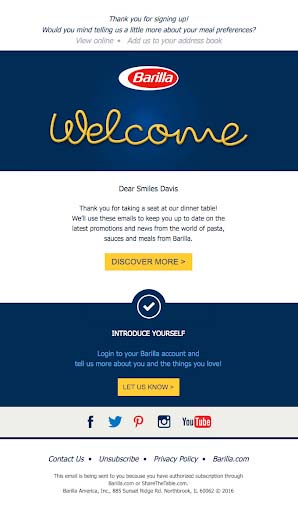
Or introduce them to your key features as UBER did.
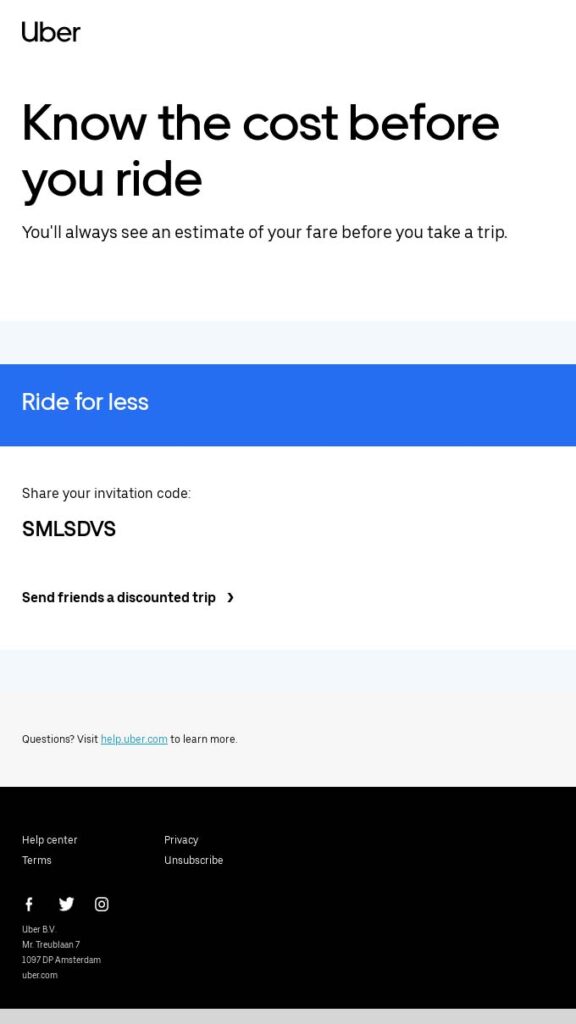
Upsell Converted Users
You converted yes, but it’s not enough. You need to repeat that process to grow your business. To target this audience, you can create a segment of users who have bought a while ago but have a low frequency. Brands often use reward points and loyalty programs to keep their customers on the radar. You can always remind them of their points or coupons when they are missing for a long time.
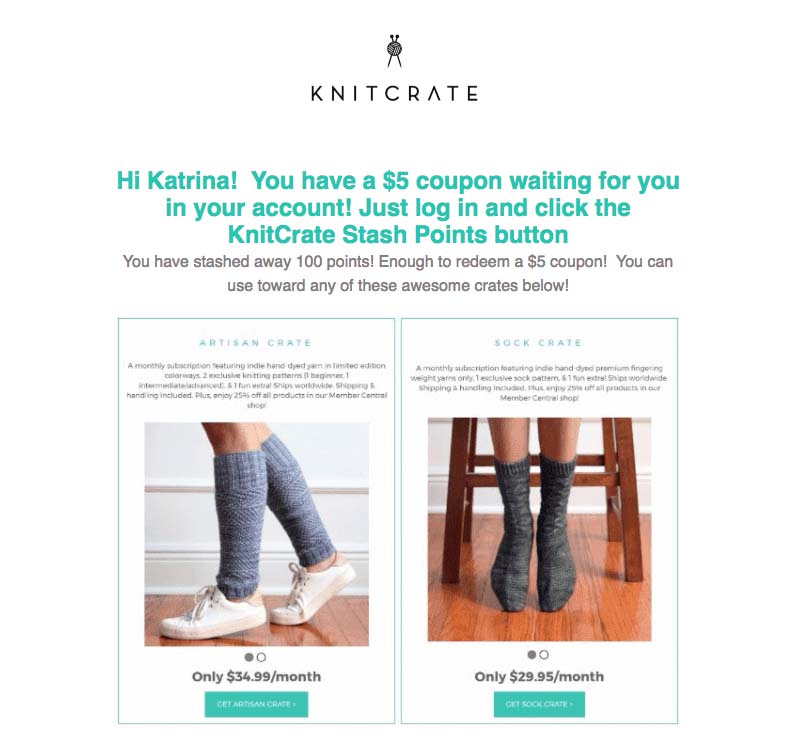
Turn loyal customers to advocates
People tend to share surprising experiences with their friends, family and colleagues. To start a word-of-mouth effect, you can create a segment of power users.
The customer profile that has high frequency purchases and activity is the right candidate for this segmentation. Let them know you love them back and encourage them to share your message.
Here, DAVIDsTEA did a fantastic job by turning the data into a meaningful anniversary celebration for their customer!
Another option to consider here is a referral campaign.
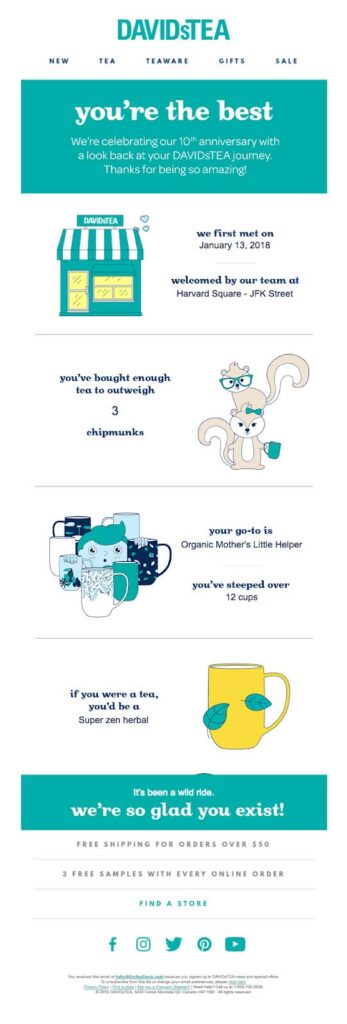
Monetize Users
Some users are highly active, but at the same time, they’re forgetful. They always leave some items in their carts. Or they’re just active. They’re surfing on your site 2 hours a day. Why not create a segment for them and send personalized recommendations or discounts based on their activity?
Here UNIQLO tries to monetize their active customers. They even attempt to upsell.
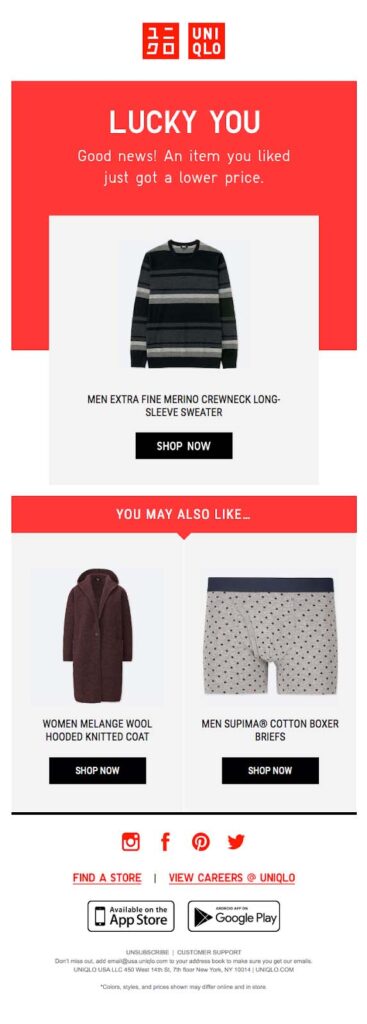
Build user habits
You need to keep your customers engaged all the time. The ultimate goal is to make them come again. Once you spend enough time together, you’ll learn more about them. Then you can create meaningful segmentation that appeals to their taste.
Airbnb plays smart here. After this mail, their customer knows that she can also look for activities on Airbnb.

Here OpenTable recommended new options that match with their customers tastebuds.
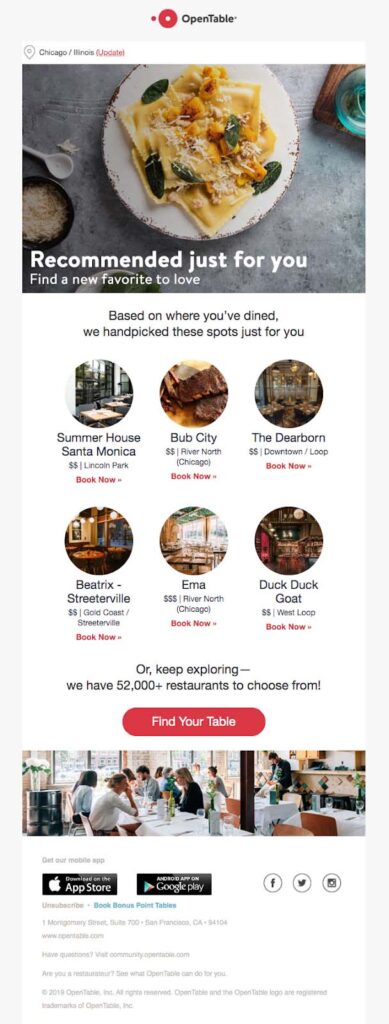
We hope these best practices and examples have increased your appetite for segmentation.
You’ll now see stories from three industries: Retail, education and insurance. These stories can teach you how to implement the best practices to increase your marketing ROI.
How Can SFMC Customer Segmentation Help You To Increase Your Revenue: Three Scenarios
To make the benefits of segmentation more visible, we wrote three scenarios for three different industries. We chose the retail, education, and insurance industries because these are amongst the biggest user bases of Salesforce Marketing Cloud.
Are you in another industry and want to get inspired with some scenarios for your segmentation strategy as well? We would love to hear from you and share our ideas!
Here the goal is to practice what we learned in the previous chapters and consolidate all the information in the SFMC environment.
A segmentation story for the retail industry
Mary is a digital marketing expert and works for a famous streetwear brand. She found out there is an interesting connection between two products, A vintage shirt (product A) and a skirt (product B).
These are two top-selling products that fall under a similar type of fashion taste. Moreover, they are complementary products. She brainstorms a bit and decides to check her data extensions on SFMC. Her goal is to cross-sell these two products.
What does she think? She wants to compare contracts with purchases made 3-6 months ago for product A, and offer product B to the same audience of fashion lovers.
Mary needs 4 DEs from the model
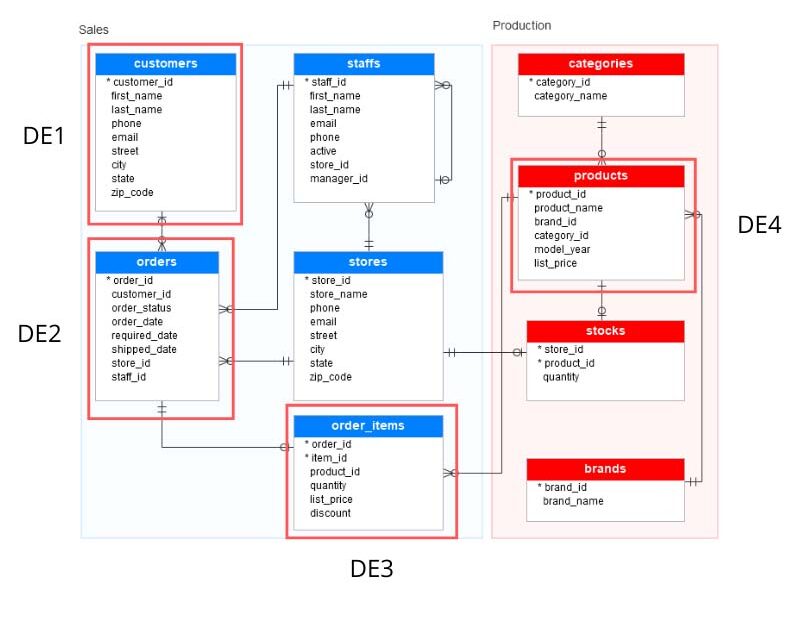
First, Mary needs to match customers with orders so she can link all transactions to the correct customer (link DE1 with DE2 based on the customer_id field).
Now, she has the correct transaction, but Mary doesn’t know which items were ordered. She will link order_items to the orders table (DE2 with DE3 based on the order_id field). Items are now represented by ID, but Mary would like to make a filter based on the name of the product and not just on a numeric ID.
She has to add one more DE. She will link the products DE to the order_items (link DE3 with DE4 based on the product_id).
Cool! Mary now knows every product that has been bought by any customer! She’s almost there! She wants to filter our results based on the Order date.
Criteria: Order_date between
Value: X and Y dates.
Now Mary knows who has ordered a product in the past 3 months. The next step is to find out who ordered product A.
Criteria: Product_name Equals to
Value: Vintage Shirt
Voila. Mary has all the contacts that ordered the shirt in the last 3 months.
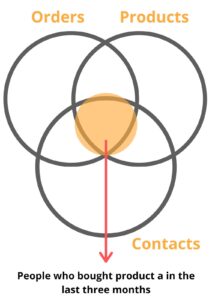
She can now send them a personalized email to recommend the skirt.
A segmentation story for the education market
Clara is a marketing and CRM expert at a University. The university recently launched a new program that covers the cryptocurrency topic.
So her goal is to inform people about the course.
Since the course is new, she wants to reach the people who are possibly interested in the course. She doesn’t want to use the blanket approach to prevent attrition.
She thinks the best way is to reach people who previously enrolled in a class similar to this topic. Maybe the topics related to finance, economy and management.
Let’s see which data extensions she can use here.
Our data model contains the following tables (Data Extensions)
- Contacts (DE1), potentially broken up into
- Students
- Leads
- Alumni
- Teachers
- Companies (in case the university/education platform/… sells to companies)
- Programs (e.g. bachelors / masters / PhD… (DE2)
- Courses (as part of a program) (DE3)
- Enrollments (linking contacts to either programs or courses) (DE4)
- Communication Preferences (like email subscriptions to info about courses)
- Events
- Event Attendees
We are interested in using the Contacts, Programs, Courses and Enrollments data extensions.
Clara will first match the contacts DE with the programs DE, this way she knows exactly which student followed which program.
To do this, she needs to match Contacts (DE1) with Enrollments (DE4) first. The enrollment data extension is the link between contacts and the study program.
We could now link the Enrollments (DE4) with the Program’s data extension (DE2).
Now we can link Program (DE2) with the Courses (DE3), so we have an idea which courses a particular student followed.
She successfully aggregated all the data. But not everyone would be interested in our new study program. That’s why she’s now going to put a filter on our results.
She wants to only focus on students who enrolled at least 3 years ago and at maximum, 10 years ago.
Criteria: enrollment date between
Value: (today – 3 years) and (today – 10 years)
She will now make sure that only the people who followed a specific course are leftover.
Criteria: Course name equals
Value: Course A or Course B or Course C

A segmentation story for the insurance market
Dick is the marketing director of an insurance company. In the last three months, they’ve been struggling to cross-sell their dental insurance plans to existing customers.
Now he wants to create a segment with customers that already bought a specific category such as personal accident insurance. Then he’ll make a filter, so he only sees the customers who haven’t purchased dental insurance yet.
Afterward, he can reach out to this audience and offer them a package discount. Such as:
Protect your smile against accidents. Customers who have personal accident insurance can benefit from dental insurance with a 30% discount.
Cool! Let’s see how he can create that segment in the SFMC environment.
Data model:
Contacts (DE1)
Opportunities (DE2)
Quotes (DE3)
Contracts (DE4)
Policies (DE5)
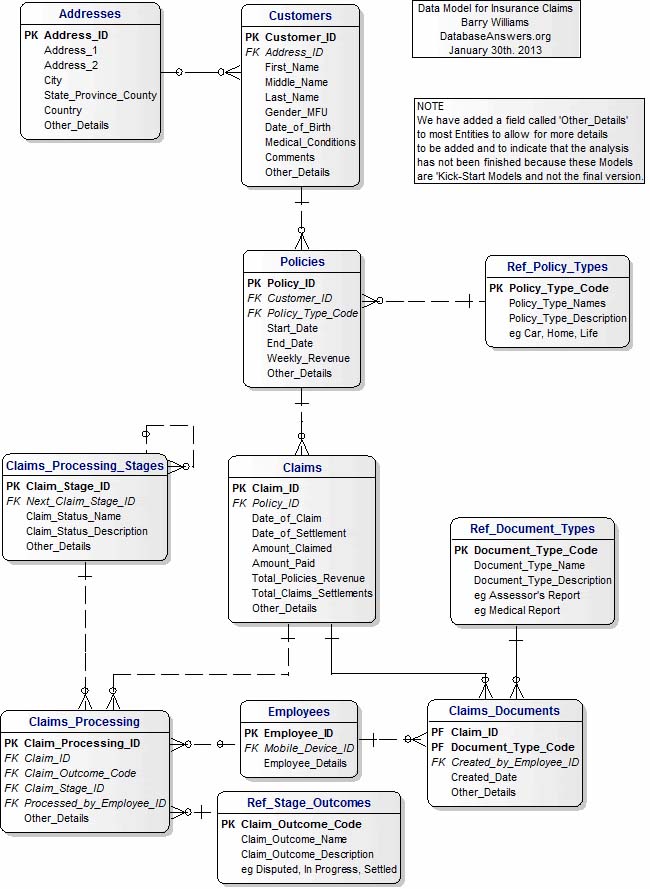
Example data model taken from: http://www.databaseanswers.org/data_models/insurance_policies_and_claims/index.htm
Dick first needs to match Contacts (DE1) with Contracts (DE4). A contract has a start and end date and can be linked to certain policies. And that’s exactly what we are going to do.
We’ll link Policies (DE5) with Contracts (DE4).
Now, he has all the contracts and policies linked to the customers.
Of course, he’s not going to send a campaign to all current customers. He’s going to filter them, so he only keeps the relevant ones.
Let’s first find all customers with an active contract.
Criteria: contact end date greater than
Value: today
Next, he’ll find all the people with personal accident insurance.
Criteria: Policy name equals
Value: “personal accident insurance”
That’s it! Now Dick has the right segmentation to send a well-crafted targeted email campaign.
Let’s talk about SQL a bit, and then I have a little BIG surprise for you!
Using SQL In SFMC For Segmentation: A Quick Intro
SQL queries offer an advanced method to segment and in general, manage data for a specific campaign. You can segment data extensions in Salesforce Marketing Cloud using SQL queries.
There are many possibilities to adapt the query to your needs.
For instance: You can rename fields using ‘as’. (e.g. your initial DE contains a field ‘email’ but your target DE ‘email address’)

Use ‘where’ to indicate you will specify criteria. (e.g. you have a field with a type of company and you would like to filter only on the ‘prospect’ type)
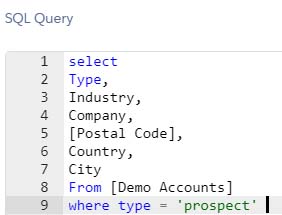
You can combine criteria using ‘and’, ‘or’ and ‘not’ (e.g. you would like to filter not only on the ‘prospect’ companies but also on the ones who are classified as ‘clients’ in the ‘type’ field).

If you need a quick introduction to SQL in SFMC, you may want to check out our post here.
As you see, these are some easy examples. But what about more complex queries like combining three data extensions with different requirements?
Complicated segmentations can be time-consuming and brain-melting, even if you know SQL.
Combining Different Data Extensions: SQL Without Training Wheels
So what about using SQL when you want to combine different data extensions (like we discussed in the scenarios above)? Well, it’s not that easy, as you need to know how to write SQL to combine two or more different data extensions. Complicated segmentations can be time-consuming and brain-melting, even if you know SQL.
Below is an example. Mary is attempting to build a combined data extension from 3 other related data extensions via SQL. She is trying to connect 3 data extensions that are connected via Account Id to target particular subscribers. She wants to create a targeted campaign, so she adds certain filters to segment that audience:
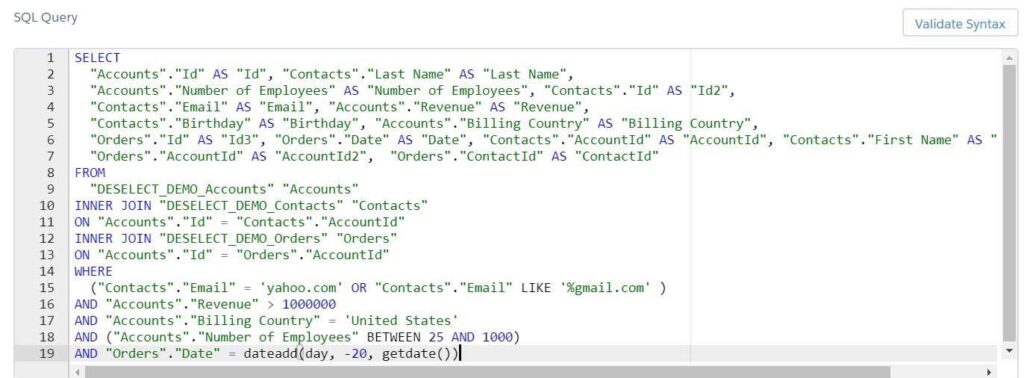
As you can see, writing a query like this, or when you actually want to implement any of the scenarios described above, it quickly becomes more complex. It is possible to learn SQL, but it does take some diligence and motivation to master.
Is There A Better, Faster, And Leaner Way For Segmentation in Salesforce Marketing Cloud?
In short, yes. But first, we want to illustrate a company’s SFMC segmentation process, so we can explore better ways to optimize this. And of course, we’ll discuss how it influences your organization.
With SFMC segmentation, you have three main problems:
SQL dependency
You will often need a data engineer or developer for campaigns that consist of two or more data extensions. And even though you or the SFMC expert know how to write SQL queries, you must know that it can be mind-boggling to create complex segmentations.
Flexibility
You had a better idea for your next campaign at the last minute. Or you just wanted to change an element in the segmentation.
You need to write a SQL query again. Worse, you’ll send that to your data engineer, and he’ll get back to you when he’s available.
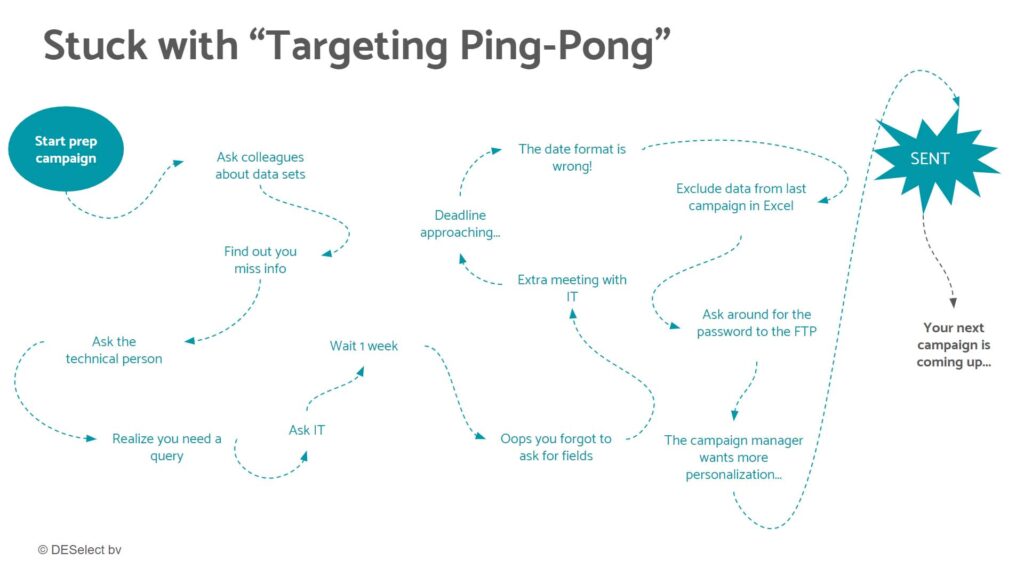
Human Factor
SQL queries are painful because whoever writes them needs to double-check and de-bug when necessary. The consolidation of Excel files, again, is very risky.
These kinds of manual processes to create segments can often result in errors.
Time
All the factors above will cost you time. Errors, dependency or complicated segmentations can fling your deadlines back for weeks.
All these problems will decrease your revenue. And worse, it’ll create a slowpoke culture within your company.
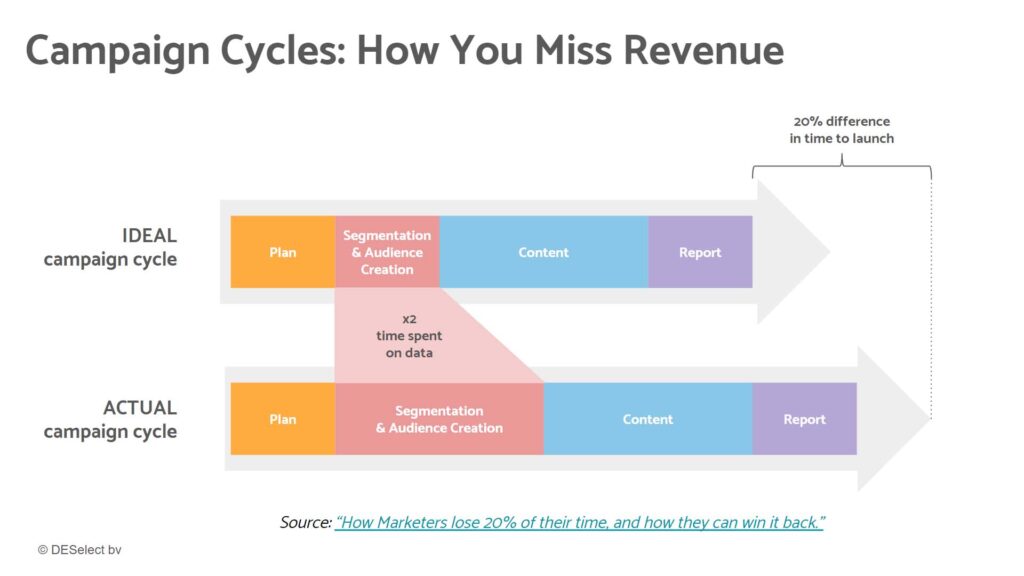
How Can You Save Time (Up To 40%) And Increase Your ROI With Drag-And-Drop SFMC Segmentation?
Let’s first define drag-and-drop segmentation, in case you haven’t heard the term before.
Drag and drop segmentation provides a simple way to combine and filter data extensions inside your SFMC platform.
Remember Mary (the retail example) from the chapter before? At the end of this section, we’ll demonstrate the same scenario with the DESelect drag-and-drop segmentation tool.
Then we’ll show you SQL and drag-and-drop processes side by side. But let’s first focus on the benefits.
The biggest 4 benefits of using drag-and-drop segmentation
No SQL (Less or even no technical involvement):
This might be one of the most significant benefits. You don’t need to have to write long and tedious SQL.
Or better, you don’t have to transfer all your marketing knowledge and campaign ideas to someone who knows SQL. You’ll never ever encounter frustrating human errors.
Nobody will ever throw toxic complaints about that cumbersome segmentation process.
Save 20% – 40% of your time.
Ok, you’re not writing SQL, but how fast is drag-and-drop? You’ll see it soon. But for now, take the word of the CRM and Email Marketing Manager at Bonobos.
“It’s surprising how much time it has saved me. Instead of creating new and multiple automations in Automation Studio, which is really time-consuming, I can create an audience segment that I use regularly and schedule them to run every day in DESelect.”
Junior Galvez
CRM and Email Marketing Manager at Bonobos
Want to know why Bonobos switched from SQL to drag and drop? You can read the case study here.
Look here, this is the timeline of the classic SFMC campaign
- Reporting: 17%
- Content and Testing: 38%
- Campaign Selections: 37%
- Planning and Strategy: 8%

See how campaign selections make up a massive chunk of 37%. Imagine a one-week campaign. The team kicks off the day with planning and strategy, then at noon, a marketer starts making the campaign selection.
It would take until Wednesday noon before she can finally switch to writing content. Now let’s see the normal campaign selection process versus the drag and drop process.
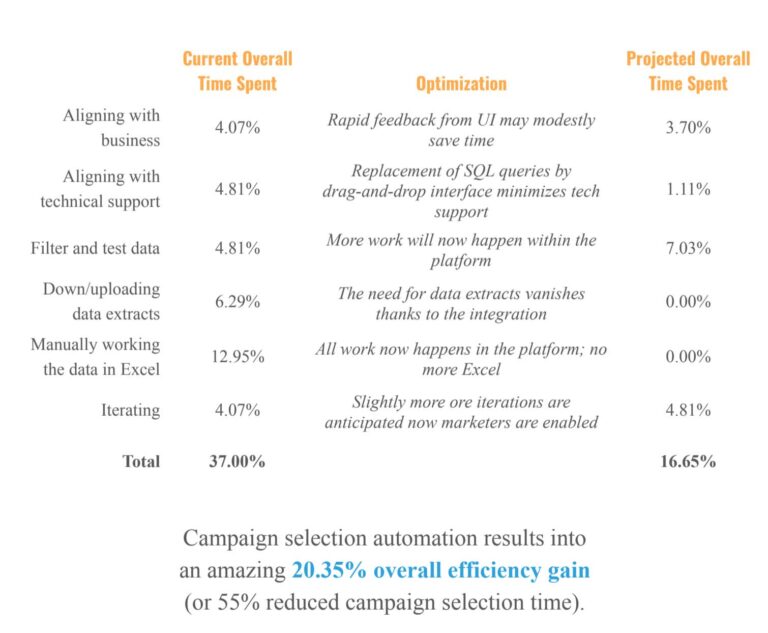
As you see, she could easily start to think about the content on Tuesday. Or the team could spend more on planning to create a better campaign. Or, however you like. That time is yours now.
Increase in revenue
The ping-pong process we mentioned earlier often causes lagging. A one or two-day delay may seem small, but if it’s a repetitive issue that could lose you a lot of money.
If you’re planning to launch a campaign every month, you can end up with less than ten campaigns per year.
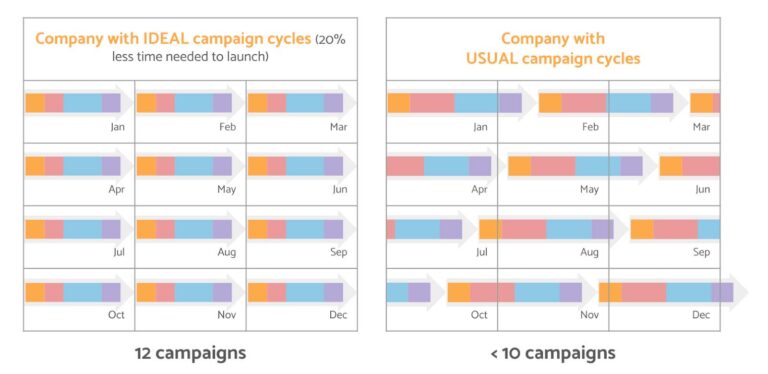
Single-source and flexible campaigns
You know how it goes with the ping-pong approach. You’re dependent on others when you want to change, add, or remove anything from your queries.
What if you have a new idea for the campaign? You know it would be better, but it’s impossible to do it in such short deadlines.
We think marketing should stay in marketers’ hands. They should be able to play around with their campaigns freely and discover new possibilities.
That’s what drag and drop provides to organizations. Freedom and flexibility for you or your marketers.
That’s why we came up with DESelect Segment, offering no-code audience segmentation for Salesforce Marketing Cloud.
Do you want to see drag-and-drop segmentation in action? I will provide you with a brief glimpse into segmentation using DESelect, so you have an idea how easy it can be!
Segmentation With DESelect
Let’s go back to the case of the retailer, Mary, from the second chapter. Let’s see how Mary would have done the segmentation with DESelect.

As you can see all the available data extensions in our SFMC business unit can be found in DESelect as well. This includes standard DEs, synchronized DEs, Salesforce DEs, data views, and even DEs shared with this business unit.
Here, Mary can simply drag and drop data extensions that she needs for her campaign to the right. She will start with Accounts and then will drag and drop Contacts on top of the Accounts DE. Here you can see the magic of DESelect in action!
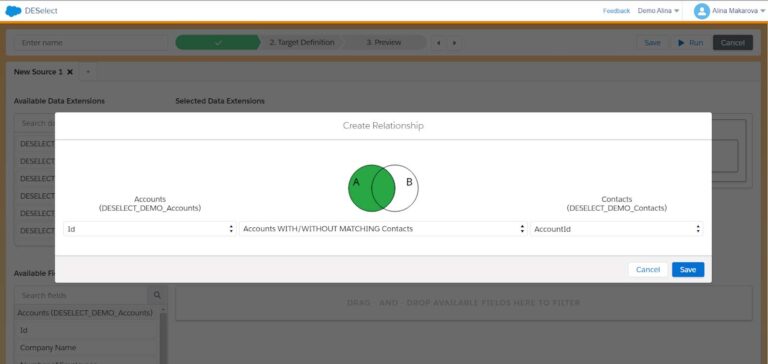
Mary can easily indicate the relationship between her data extensions. For this campaign, she would like to target only those Accounts that have a matching Contact to them.
Later, she needs to choose how she would like to connect those DEs and this time they will be connected by Account Id. In order to link the Orders with Accounts, she will simply drag and drop Orders DE on top of the Accounts. Again, she would connect only those Orders that are linked to the Accounts using the Account Id.
You can see for yourself how quickly a selection can be done using DESelect in comparison with the time normally spent writing SQL queries.
Looks promising, right?
About
DESelect is the marketing optimization platform (MOP) for Salesforce. DESelect helps marketers drive more revenue with high efficiency, thorough frequency optimization, segmentation, and search. Our turnkey platform is fully integrated with Marketing Cloud.
Interested in learning how DESelect can help you instantly optimize Salesforce Marketing Cloud? Book a 1:1 demo here with one of our experts.
